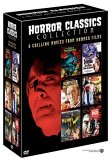Synopsis
In 1957, the British studio Hammer, having already produced a number of classic SFthrillers, turned to gothic horror, which had been effectively dead since 1946, and brought it backwith a vengeance. Their revolutionary entry was The Curse of Frankenstein (****1/2),which introduced colour, gore and sex to the classic horror formula, and made Peter Cushing (asFrankenstein) and Christopher Lee (as the Creature) into stars. Unlike the Universal Frankensteinfilms of the 3…s and 40s, the continuing character is Frankenstein, rather than his creation, andCushing’s amoral yet charismatic incarnation of the Baron is still the best yet seen. In this film,he makes his first stab at creating life, sewing the creature together from bits and pieces, andstopping at nothing (including murder), to get what he needs.
Hammer confirmed that Terence Fisher’s film was no fluke when they released Horrorof Dracula (****1/2) the following year. Here Lee is the magisterial Dracula, and Cushing isa very energetic Van Helsing. In some quarters, this film is hailed as Hammer’s finest effort, andLee as the greatest Dracula. I’m leery of such absolute pronouncements, but the lush, romantic,exciting film is undoubtedly a contender for the top spot.
Lee, Cushing and Fisher teamed up again in 1959 for The Mummy (***1/2). Thoughcompletely encased in make-up, Lee nevertheless does wonders with his eyes as Kharis theMummy, easily putting Lon Chaney’s 40s portrayal of this character in the shade. The plot is thefamiliar tale: English archaeologists dig up the tomb of the Princess Ananka, and the desecratorsare killed one by one by Kharis, who is under the direction of a vengeful Egyptian. Impressiveas Lee is, the film is hobbled by an overlong flashback sequence that kills the pace dead.
Cushing played Frankenstein five more times, and 1969’s Frankenstein Must BeDestroyed (****1/2), the next-to-last film in the series, is also one of the best. His new thinghere is brain transplants, and there is nothing particularly monstrous about his experiment’sappearance. Instead, Frankenstein himself is the monster (as the opening sequence makesexplicitly clear), and this film features him at his most sadistic. At the same time, his rapier witdraws viewers to him even as they recoil in horror.
Lee returned as Dracula in Dracula: Prince of Darkness (1965, available from AnchorBay). His third and fourth appearances (from 1968 and 1969) are included here. Dracula HasRisen from the Grave (***1/2) sees him seeking revenge on the cleric who performed anexorcism on his castle. Dracula target’s the man’s niece, incidentally causing her atheistboyfriend to re-evaluate his beliefs. Freddie Francis’ film is handsome and fun, but isn’t a patchon what came next.
Peter Sasdy’s Taste the Blood of Dracula (****) is one of the high points of theseries. Finally set in Victorian England, rather than the Cockney-accented Eastern Europe of theearlier films, this story makes great hay with the hypocrisies of Victorian sexuality. Whilerepressing his wife and daughter and maintaining a facade of rigid respectability, Geoffrey Keenespends his nights carousing in a brothel with two similarly dissolute friends. In search of newexperiences, the trio become involved in a black magic ceremony, but panic and kill adept RalphBates. The resurrected Dracula, enraged at the death of his servant, gets his revenge byvampirising the children of the three men. Though the climax isn’t a cleanly staged as it mightbe, the thematic wealth of the film (not to mention that this is, apparently, its first uncut NorthAmerican appearance), make it a stand-out member of the collection.
Audio
Original mono sound all round. Generally speaking, the sound is crisp and clean. There isno background hiss, and no distortion to speak of (especially considering the films’ age). Thereis a bit of gurgling on The Mummy, but the flaw isn’t severe.
Video
The colours are all six films are sumptuous. This is Hammer as it should be experienced.The prints are in very good shape, with only very slight speckling now and then. The grain isminimal, and what is present is, again due to age, more or less to be expected. There is someminor flicker on Dracula Has Risen from the Grave. All of the films are presented inanamorphic widescreen, 1.78:1 from the looks of it.
Special Features
Very sparse. All the films have their theatrical trailers. The Mummy, The Curseof Frankenstein and Horror of Dracula also have a cast and crew list, and thelatter two have a brief essay about their respective series. The menus have scored mainscreens.
Closing Thoughts
Thin on extras, but the picture quality is very high, and the collection is a fine look atHammer at its peak. Highly recommended.
Special Features List
- Trailers
- Cast and Crew Lists
- Short Essays






